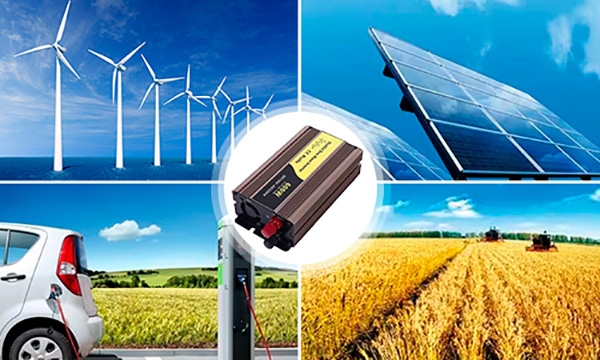A power inverter is a device that converts direct current into alternating current, which plays an important role in modern society. Inverters are widely used in various fields, including household use, industrial production, electric vehicles, transportation power, agricultural development, and renewable energy fields, to name a few. It has a variety of functions, including not only converting direct current to alternating current, but also changing the frequency of the current, regulating the stability of the voltage, and improving the quality of the power.
Renewable Energy Power Generation
The main function of an inverter is to convert direct current (DC) to alternating current (AC). This is particularly important in many renewable energy systems, such as solar and wind systems. In these systems, the electricity generated by photovoltaic panels or wind turbines is DC, while most household and commercial equipment requires AC. Therefore, inverters are the key devices for this conversion. Solar and wind power are more common among renewable energy sources.
Solar Power Conversion: In a solar power system, photovoltaic (PV) panels produce direct current (DC) electricity. A power inverter converts the DC power generated by the PV panels into AC power so that it can be supplied for domestic, commercial or industrial use. This conversion not only improves the efficiency of power utilization but also allows the solar power system to interoperate with the conventional power grid to provide a stable supply of power to the user.
Wind Power Conversion: Wind power also produces direct current (DC) electricity, which needs to be converted to alternating current (AC) using a power inverter. Inverters in wind power generation are usually designed with high efficiency to ensure a stable power output even when the wind is unstable. Additionally, power inverters are equipped with protection features to protect wind turbines from damage by automatically shutting down when wind speeds are too high or too low.
Electric Vehicles
Power inverters play a vital role in electric vehicles. Modern cars are equipped with a large number of electronic devices, such as navigation systems, audio systems, on-board computers, and so on. These devices need stable AC power to drive them, and the power inverter can convert the DC power from the car battery into AC power to provide a stable power supply for these devices.

Specifically, the inverter of an electric vehicle converts the DC power from the power battery into the three-phase, high-voltage AC power required by the electric motor by receiving driving control commands from the vehicle controller. This conversion process allows the electric motor to operate efficiently and stably, thus enabling the EV to be driven.
Electric vehicles use a battery pack to store electrical energy, which is DC. When the electric vehicle needs to drive the electric motor, the power inverter for car converts the DC power to AC power to supply the electric motor. The inverter is also responsible for converting AC power from an AC charging station to DC power to charge the battery pack of the electric vehicle during the charging process of the electric vehicle.
Industrial automation control
In industrial automation control systems, power inverters are widely used to supply power to various devices such as sensors, actuators, and controllers. These devices usually need stable AC power to drive them, and power inverters can provide stable AC output with protection functions such as over-current, over-voltage, and under-voltage to ensure the stable operation of industrial automation systems.
Industrial production often requires a high-power power supply, and the inverter can provide stable high-quality AC power. The frequency adjustment function of the inverter can meet the requirements of different equipment on the power supply frequency, to ensure the normal operation of the production equipment. In addition, inverters can also regulate the stability of voltage, protecting equipment from voltage fluctuations and prolonging the service life of equipment.
Power supply for household appliances
For home use, inverters can convert DC power sources such as solar panels into standard AC power for home appliances. Taking solar power as an example, a power inverter converts the DC power obtained from solar panels into AC power suitable for home appliances, so that solar power can be self-sufficient. This not only helps households save on energy costs but also reduces dependence on traditional energy sources, thereby protecting the environment and promoting sustainable development.
In remote areas or where electricity is unstable, power inverters can provide a stable AC power source for household appliances. By converting car batteries or other DC power sources, power inverters can ensure the proper functioning of household appliances such as TVs, refrigerators, and lighting.
In a home backup power system, a power inverter is usually connected to a battery to provide an emergency power supply to the home. When the regular power supply is interrupted, the inverter automatically kicks in and converts the DC power from the batteries into AC power to provide power to important devices in the home such as lighting, refrigerators, communication devices, etc. This helps to ensure the basic needs of family members in emergencies.
Power for Transportation
Power inverters also play an important role in the field of transportation power. For example, railroad locomotives, subway trains, and other vehicles require stable AC power to drive various equipment. Inverters convert the DC power supply of these vehicles into AC power to ensure the normal operation of the equipment. In addition, in the aviation field, inverters are also used to convert DC power from aircraft batteries to AC power to provide power for electronic equipment on the aircraft.
Agriculture
Inverters also play an important role in the agricultural sector. Rural areas are often characterized by unstable power supply. Inverters can convert renewable energy sources such as solar and wind power into AC power to supply agricultural facilities such as farm irrigation systems and breeding equipment. Through the application of inverters, farmers can realize self-sufficiency in electricity, no longer limited by the grid supply, improve agricultural productivity, and contribute to rural economic development.
